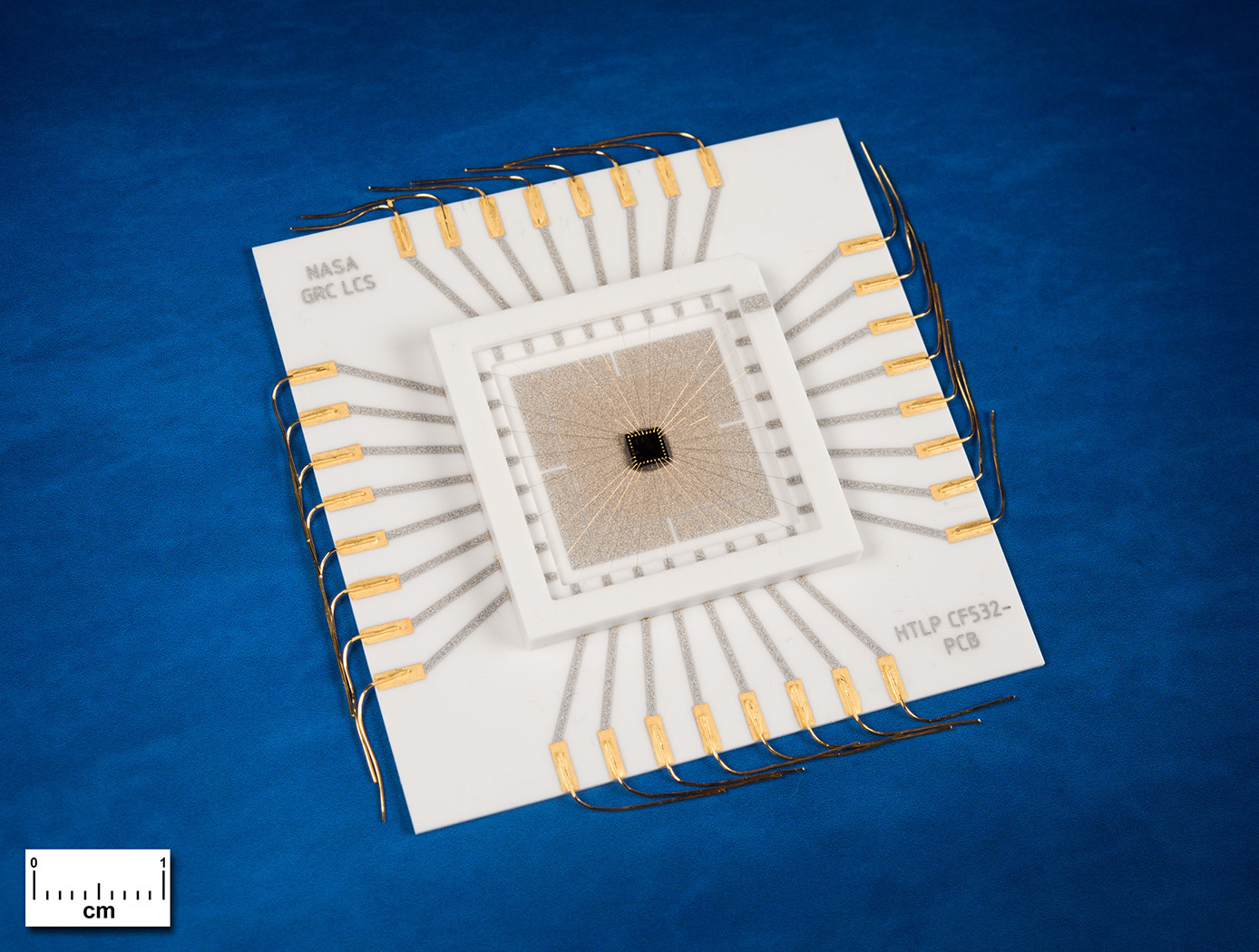Integrated Circuit Chips
Electrical and Electronics
Integrated Circuit Chips (LEW-TOPS-33)
Robust, embeddable logic and mixed signal integrated circuits for extreme environments
Overview
Innovators at NASA's Glenn Research Center have developed a new generation of silicon carbide (SiC) logic and mixed signal integrated circuits (ICs), unprecedented in the field of high-temperature electronics. Previously, SiC ICs could not withstand more than a few hours of 500°C temperatures before degrading or failing. Now, NASA Glenn has successfully fabricated prototypes that consistently exceed 1,000 hours of continuous operation at 500°C. The superior performance stems in part from previous Glenn advancements, such as the iridium interfacial stack (IrIS), a bondable and durable metallization stack that enables electrical packaging connections to SiC integrated circuits operating above 500°C. The enhanced stability of these components will enable important improvements in sensing, control, and operation of harsh environment systems, by providing analog and digital circuit functionality directly where it is needed. This advancement in the manufacturing of SiC-based electronics revolutionizes and broadens the opportunities for intelligent systems by providing ICs that operate well beyond the current temperature limits of conventional (silicon) ICs.
The Technology
NASA Glenn's durable, extreme-temperature, integrated circuit chips begin with the replacement of conventional silicon IC transistors with n-channel SiC junction field effect transistors (JFET) and resistors that can reliably function above 500°C. JFETs with the necessary high-temperature stability and electrical gain are fabricated from commercial 4H-SiC wafers with epilayers using dry etching and a self-aligned n-type ion implantation. An innovative circuit approach creates digital logic gates from these normally-on n-channel JFETs and resistors. Using two levels of 500°C durable metal to interconnect numerous SiC gates, complex circuits enabling a variety of control, operation and sensing functions for intelligent systems in harsh environments can be implemented in physically small chips. The challenge of getting electrical signals to and from the chip in a harsh environment is overcome by the use of the iridium interfacial stack (IrIS) that acts simultaneously as a bond metal and diffusion barrier, and can be used on an ohmic contact to the SiC. Combined with Glenn-developed high-temperature durable ceramic chip packaging and harsh environment sensor technology, this revolutionary durable integrated circuit technology is game changing for harsh-environment applications of all types.


Benefits
- Robust: Operates at the broad temperature range of -100°C to over 500°C
- Durable: Exhibits prolonged stable operation at 500°C for over 1,000 hours
- Versatile: Offers application-specific digital and analog circuitry that can be uniquely customized
- Simplified: Enables the inclusion of intelligent electronics operating directly in the harsh environment
Applications
- System monitoring
- Aerospace
- Transportation
- Oil and gas
- Power
- Environmental monitoring
- Robotics
- Commercial space
Technology Details
Electrical and Electronics
LEW-TOPS-33
LEW-18432-1
LEW-18432-2
LEW-18736-1
LEW-18256-1
LEW-18636-1
LEW-19356-1
LEW-19391-1
LEW-19386-1
LEW-19356-2
LEW-19406-1
LEW-19695-1
LEW-19695-2
LEW-20338-1
Similar Results

Packaging for SiC Sensors and Electronics
Prior approaches to bonding a SiC sensor and a SiC cover member relied on either electrostatic bonding or direct bonding using glass frits. The problem with the former is that its relatively weak bond strength may lead to debonding during thermal cycling, while the latter requires the creation of apertures that can allow sealant to leak. Glenn's innovation uses NASA's microelectromechanical system direct chip attach (MEMS-DCA) technology that can be bulk-manufactured to reduce sensor costs. The MEMS-DCA process allows a direct connection to be made between chip and pins, thereby eliminating wire bonding. Sensors and electronics are attached in a single-stage process to a multifunctional package, which, unlike previous systems, can be directly inserted into the housing. Additional thick pins within the electrical outlet allow the package to be connected to external circuitry. Furthermore, because the top and bottom substrates' thermomechanical properties are similar to that of the sensors, the problem of mismatch in the coefficient of thermal expansion is significantly reduced, minimizing thermal cycling and component fatigue. By protecting sensors and electronics in temperatures up to 600°C, approximately twice what has previously been achievable, Glenn's innovation enables SiC components to realize one of their most exciting possibilities - direct placement within high-temperature environments.

Metallization for SiC Semiconductors
To avoid catastrophic failure, traditional electrical ohmic contacts must be placed at some distance from the optimal position (especially for sensors) in high-temperature environments. In addition, conventional metallization techniques incur significant production costs because they require multiple process steps of successive depositions, photolithography, and etchings to deposit the desired ohmic contact material. Glenn's novel production method both produces ohmic contacts that can withstand higher temperatures than ever before (up to 600°C), and permits universal and simultaneous ohmic contacts on n- and p-type surfaces. This makes fabrication much less time-consuming and expensive while also increasing yield. This innovative approach uses a single alloy conductor to form simultaneous ohmic contacts to n- and p-type 4H-SiC semiconductor. The single alloy conductor also forms an effective diffusion barrier against gold and oxygen at temperatures as high as 800°C. Glenn's extraordinary method enables a faster and less costly means of producing SiC-based sensors and other devices that provide quicker response times and more accurate readings for numerous applications, from jet engines to down-hole drilling, and from automotive engines to space exploration.

Silicon Carbide (SiC) Fiber-Reinforced SiC Matrix Composites
Aimed at structural applications up to 2700°F, NASA's patented technologies start with two types of high-strength SiC fibers that significantly enhance the thermo-structural performance of the commercially available boron-doped and sintered small-diameter “Sylramic” SiC fiber. These enhancement processes can be done on single fibers, multi-fiber tows, or component-shaped architectural preforms without any loss in fiber strength. The processes not only enhance every fiber in the preforms and relieve their weaving stresses, but also allow the preforms to be made into more shapes. Environmental resistance is also enhanced during processing by the production of a protective in-situ grown boron-nitride (iBN) coating on the fibers. Thus the two types of converted fibers are called “Sylramic-iBN” and “Super Sylramic-iBN”.
For high CMC toughness, two separate chemical vapor infiltration (CVI) steps are used, one to apply a boron nitride coating on the fibers of the preform and the other to form the SiC-based matrix. The preforms are then heat treated not only to densify and shrink the CVI BN coating away from the SiC matrix (outside debonding), but also to increase its creep resistance, temperature capability, and thermal conductivity.
One crucial advantage in this suite of technologies lies in its unprecedented customizability. The SiC/SiC CMC can be tailored to specific conditions by down-selecting the optimum fiber, fiber coating, fiber architecture, and matrix materials and processes. In any formulation, though, the NASA-processed SiC fibers display high tensile strength and the best creep-rupture resistance of any commercial SiC fiber, with strength retention to over 2700°F.

Advanced Hydrogen and Hydrocarbon Gas Sensors
In conjunction with academia and industry, NASA's Glenn Research Center has developed a range of microelectromechanical systems (MEMS)-based and Silicon Carbide (SiC)-based microsensor technologies that are well-suited for many applications. The suite of technologies includes hydrogen and hydrocarbon leak detection sensors; emissions sensor arrays; and high-temperature contact pads for wire bond connections.
Currently used to protect astronauts on the International Space Station, the hydrogen and leak detection sensors have many Earth-based applications as well. They can function as a single-sensor unit or as part of a complete smart sensor system that includes multiple sensors, signal conditioning, power, and telemetry. The system can comprise sensors for hydrogen, hydrocarbons, oxygen, temperature, and pressure. The emissions sensor array features a gas-sensing structure that detects various combustion emission species (carbon monoxide, carbon dioxide, oxygen, hydrocarbons, and nitrogen oxides) over a wide range of concentrations. In addition, the emissions sensor array remains highly sensitive and stable while providing gas detection at temperatures ranging from 450 to 600°C. These new sensors provide a combination of responsiveness and durability that offers great value for a wide range of applications and industries.

Robust High Temperature SiC Op Amps Practical Fabrication
The technology is part of a new generation of NASA Glenn SiC integrated circuits with unprecedented durability in the field of high-temperature electronics. For robust operational amplifiers based on SiC Junction Field Effect Transistors (JFETs), this novel compensation method mitigates issues with threshold voltage variations that are an effect of die location on the wafer. Modern high-temperature op amps on the market fall short due to temperature limits (only 225C for silicon-based devices). Previously, researchers noted that multiple op amps on a single SiC wafer had different amplification properties due to different threshold voltages that varied spatially as much as 18% depending on the circuit's distance from the SiC wafer center. While 18% is okay for some applications, other important system applications demand better precision. By applying this technology to the amplifier circuit design process, the op amp will provide the same signal gain no matter its position on the wafer. The compensation approach enables practical signal conditioning that works from 25C up to 500C.



